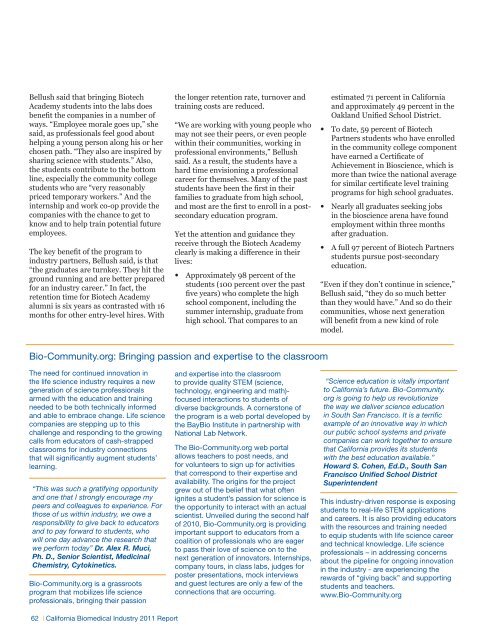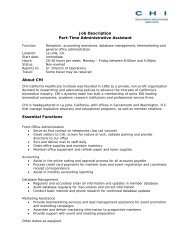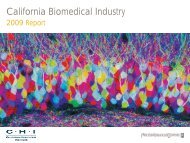California Biomedical Industry - California Healthcare Institute
California Biomedical Industry - California Healthcare Institute
California Biomedical Industry - California Healthcare Institute
You also want an ePaper? Increase the reach of your titles
YUMPU automatically turns print PDFs into web optimized ePapers that Google loves.
Bellush said that bringing BiotechAcademy students into the labs doesbenefit the companies in a number ofways. “Employee morale goes up,” shesaid, as professionals feel good abouthelping a young person along his or herchosen path. “They also are inspired bysharing science with students.” Also,the students contribute to the bottomline, especially the community collegestudents who are “very reasonablypriced temporary workers.” And theinternship and work co-op provide thecompanies with the chance to get toknow and to help train potential futureemployees.The key benefit of the program toindustry partners, Bellush said, is that“the graduates are turnkey. They hit theground running and are better preparedfor an industry career.” In fact, theretention time for Biotech Academyalumni is six years as contrasted with 16months for other entry-level hires. Withthe longer retention rate, turnover andtraining costs are reduced.“We are working with young people whomay not see their peers, or even peoplewithin their communities, working inprofessional environments,” Bellushsaid. As a result, the students have ahard time envisioning a professionalcareer for themselves. Many of the paststudents have been the first in theirfamilies to graduate from high school,and most are the first to enroll in a postsecondaryeducation program.Yet the attention and guidance theyreceive through the Biotech Academyclearly is making a difference in theirlives:••Approximately 98 percent of thestudents (100 percent over the pastfive years) who complete the highschool component, including thesummer internship, graduate fromhigh school. That compares to anestimated 71 percent in <strong>California</strong>and approximately 49 percent in theOakland Unified School District.••To date, 59 percent of BiotechPartners students who have enrolledin the community college componenthave earned a Certificate ofAchievement in Bioscience, which ismore than twice the national averagefor similar certificate level trainingprograms for high school graduates.••Nearly all graduates seeking jobsin the bioscience arena have foundemployment within three monthsafter graduation.••A full 97 percent of Biotech Partnersstudents pursue post-secondaryeducation.“Even if they don’t continue in science,”Bellush said, “they do so much betterthan they would have.” And so do theircommunities, whose next generationwill benefit from a new kind of rolemodel.Bio-Community.org: Bringing passion and expertise to the classroomThe need for continued innovation inthe life science industry requires a newgeneration of science professionalsarmed with the education and trainingneeded to be both technically informedand able to embrace change. Life sciencecompanies are stepping up to thischallenge and responding to the growingcalls from educators of cash-strappedclassrooms for industry connectionsthat will significantly augment students’learning.“This was such a gratifying opportunityand one that I strongly encourage mypeers and colleagues to experience. Forthose of us within industry, we owe aresponsibility to give back to educatorsand to pay forward to students, whowill one day advance the research thatwe perform today” Dr. Alex R. Muci,Ph. D., Senior Scientist, MedicinalChemistry, Cytokinetics.Bio-Community.org is a grassrootsprogram that mobilizes life scienceprofessionals, bringing their passionand expertise into the classroomto provide quality STEM (science,technology, engineering and math)-focused interactions to students ofdiverse backgrounds. A cornerstone ofthe program is a web portal developed bythe BayBio <strong>Institute</strong> in partnership withNational Lab Network.The Bio-Community.org web portalallows teachers to post needs, andfor volunteers to sign up for activitiesthat correspond to their expertise andavailability. The origins for the projectgrew out of the belief that what oftenignites a student’s passion for science isthe opportunity to interact with an actualscientist. Unveiled during the second halfof 2010, Bio-Community.org is providingimportant support to educators from acoalition of professionals who are eagerto pass their love of science on to thenext generation of innovators. Internships,company tours, in class labs, judges forposter presentations, mock interviewsand guest lectures are only a few of theconnections that are occurring.“Science education is vitally importantto <strong>California</strong>’s future. Bio-Community.org is going to help us revolutionizethe way we deliver science educationin South San Francisco. It is a terrificexample of an innovative way in whichour public school systems and privatecompanies can work together to ensurethat <strong>California</strong> provides its studentswith the best education available.”Howard S. Cohen, Ed.D., South SanFrancisco Unified School DistrictSuperintendentThis industry-driven response is exposingstudents to real-life STEM applicationsand careers. It is also providing educatorswith the resources and training neededto equip students with life science careerand technical knowledge. Life scienceprofessionals – in addressing concernsabout the pipeline for ongoing innovationin the industry - are experiencing therewards of “giving back” and supportingstudents and teachers.www.Bio-Community.org62 | <strong>California</strong> <strong>Biomedical</strong> <strong>Industry</strong> 2011 Report






